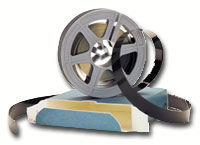
Handling of microfilm
Care needs to be taken with microfilm to avoid scratches, abrasions and fingerprints when handling and viewing in a microfilm reader. It is essential to use clean white gloves when handling microfilm since naturally occurring oils, acids, and other residues on fingertips can damage the emulsion. Cotton fabric does not generate static which attracts dust. Microfilm should only be held at the edges. After use, microfilm and microfiche should immediately be put back into storage.
Use of equipment
Microform readers generate heat and should be turned off when not in use. Microfilms can be viewed for normal periods in microfilm readers with reader-gate temperatures not exceeding 75-C (167-F) as specified by ANSI standards. Unnecessarily long exposure in readers should be avoided with all types of microfilm, particularly diazo films which are easily damaged at this temperature. The master negative should not be used in a reader. Its silver gelatin emulsion is highly vulnerable to physical damage and just a few passes through a poorly maintained reader/printer can severely scratch the emulsion.
The microfilmed image is usually reduced between 8x and 14x, so the reader lens magnification should be in similar ratios. Zoom lenses, which allow for changing magnification, are available.
It is important to maintain and inspect equipment regularly; glass surfaces, the matte surface of viewing screens, and carriers should be cleaned daily. Dust on glass flats will be magnified and reduce the quality of the image, grime on the edges of glass flats will cause film abrasion. Dust transferred to the microform may obscure details, or worse, damage the film. Dust covers should always be used whenever the film reader is not in use.
Source: Kodak. (2009). Kodak publication D-49: Kodak thermal print microfilms. Retrieved February 25, 2011, from http://graphics.kodak.com/docimaging/uploadedFiles/D49_Thermal_1323_1353_2353.pdf
Source: New York State Archives. (2010). Storage and preservation FAQS. Retrieved February 25, 2011, from http://www.archives.nysed.gov/a/records/mr_storage_faqs.shtml
Source: Northeast Document Conservation Center. (2000). Microfilm and microfiche. Retrieved February 25, 2011, from http://www.nedcc.org/resources/leaflets/6Reformatting/01MicrofilmAndMicrofiche.php